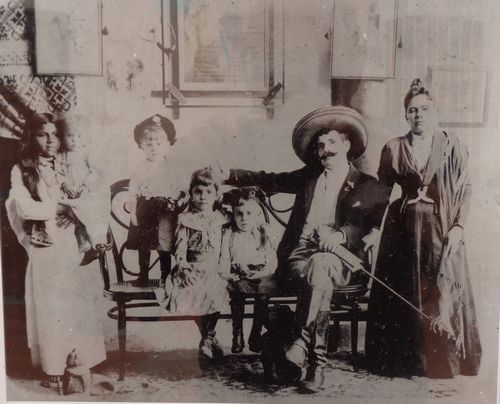Hacienda Miramar

photograph with 'Blick van Hacda Miramar 1916' on reverse
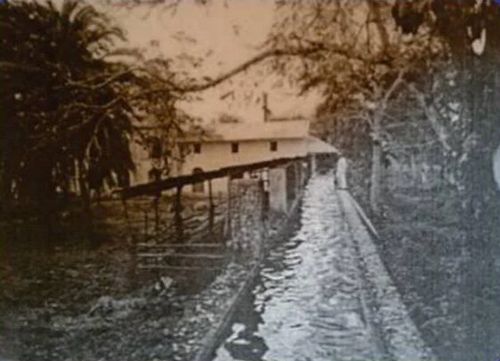
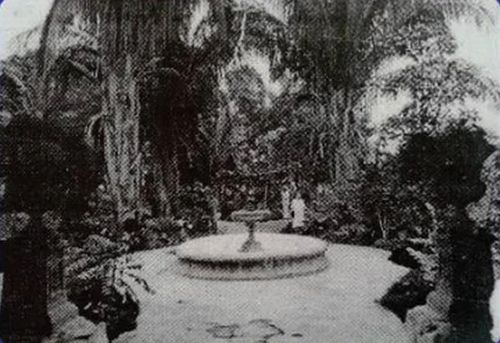
Douglas Weatherston and his family
The Hacienda Miramar was a coffee plantation about ten kilometres south of Misantla. Douglas Weatherston was a Canadian from Toronto who came to Misantla from Durango in 1894 and bought the Hacienda Miramar around 1904.
Weatherston issued two sets of notes to make up for the absence of official currency, to be exchanged for banknotes in multiples of five pesos. The text reads “Estos cheques suplen al numerario: por consiguiente sólo serán cambiados por billetes de Banco no menores de cinco pesos”. On some notes with a datestamp from 31 August 1915 “de Banco” is crossed out.
These had the signature of Weatherston, printed on the first set and hand-signed on the second.
Because of a lack of revenue stamps some notes have the handwritten or typed comment “Legalizado. Art 246 Ley del TimbreLegalised in accordance with article 246 of the general legalisation on stamp duty (Ley de la Renta Federal del timbre) of 1 June 1906. which make provision in the event of a lack of revenue stamps and states that the holders of documents should present them to the oficina del Timbre and the jefe will certify that the holder has paid cash in place of the required stamps (Art. 246. Si en algún lugar faltaren estampillas, el que necesite timbrar un documento ó libro lo presentará á la oficina del Timbre para que lo legalice, previo el pago del impuesto de las estampillas que debieran usarse, y poniendo una nota de legalización que autorizará el jefe de la oficina, quien expedirá al interesado una certificación de haber hecho el pago en efectivo por falta de estampillas). The following article 247 states that this certification will only last for two months, after which the holder needs to represent the documents for the necessary stamps to be attached (Art. 247. La referida legalización solamente surtirá efectos durante el término de dos meses, pasados los cuales el documento ó libro se tendrá como no timbrado si no se le hubieren adherido las estampillas faltantes. A este fin, los interesados concurrirán á la oficina del Timbre, dentro de dichos dos meses, y canjearán el certificado por las estampillas correspondientes, que se les ministrarán sin causa de nuevo pago, y se adherirán y cancelarán por la misma oficina en el documento ó libro respectivo. Si el documento no estuviere en poder de la persona que hubiere pedido su legalización, recogerá las estampillas en cambio del certificado y cuidará de remitirlas al tenedor del documento para que éste las adhiera y cancele en la forma legal, con la fecha en que sean adheridas) / Misantla,' and a date with the stamp of the Oficina de Hacienda and signature of the Administrador, A. Celis Huerta; others the note “Legalizado. Art. 246 / Ley del Timbre / Misantla mayo de 1915” with stamp and signature, and others “No hay timbres. / Misantla. Junio 2 de 1915”. The numbering shows that these notes were not issued sequentially but in batches: so another avenue for a researcher.
First series
50 centavos
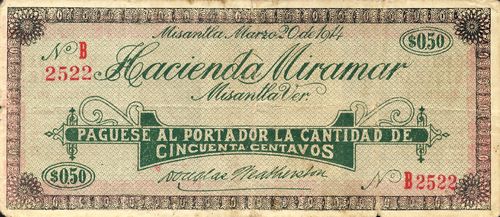
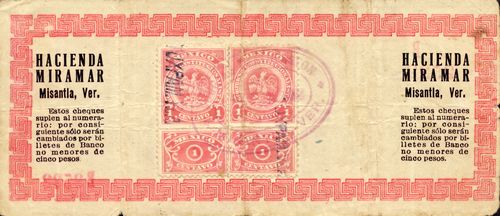
| Date | Additional date on note |
series | from | to | total number |
total value |
||
| 50c | 20 March 1914 | B | revenue stamps includes numbers 0523CNBanxico #6405 revenue stamps have been removed to 2747CNBanxico #12309 |
One peso
and a companion to the first issue, dated 1 July 1914 (so, actually, after the second issue below and probably issued in April to June 1915).
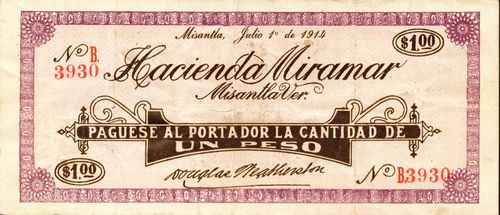
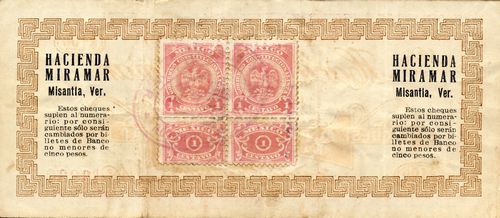
| Date | Additional date on note |
series | from | to | total number |
total value |
||
| $1 | 20 March 1914 | B | includes numbers 0356 to 3327 | |||||
| 1 July 1914 | revenue stamps includes numbers 1944 to 3930no revenue stamps on $1 B 2901 (CNBanxico #12310) |
|||||||
| 17 September 1914 | Typewritten 'Legalizado' includes number 3273 |
|||||||
| remainder includes number 3944 |
Two pesos
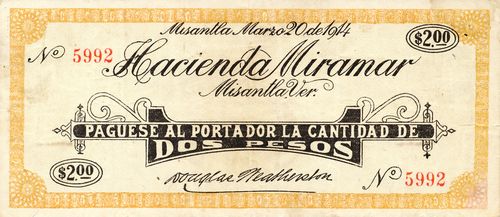
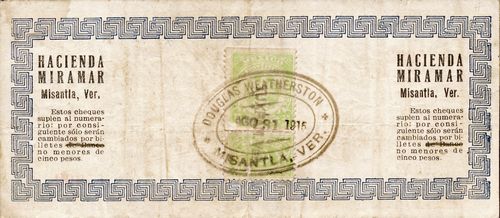
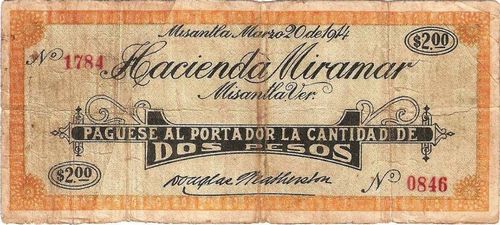
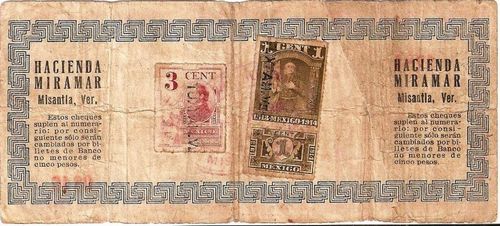
Serial number 1748/0846 shows that this note has been reconstructed from two different halves
| Date | Additional date on note |
series | from | to | total number |
total value |
||
| $2 | 20 March 1914 | revenue stamps includes numbers 0585CNBanxico #6408 to 5184 |
||||||
| [ ] July 1915 | Typewritten 'Legalizado' includes number 1628 |
|||||||
| revenue stamps includes numbers 5458CNBanxico #12311 to 5986 |
||||||||
| 31 August 1915 | revenue stamps includes number 5992 |
Second series
Weatherston then arranged another series of notes, dated 20 May 1914, though according to the additional dates written on the notes they were issued from April to June 1915.
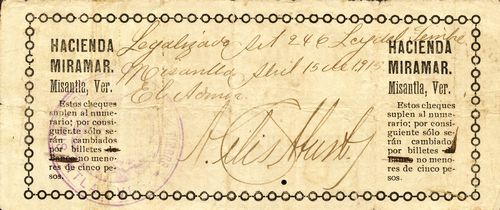
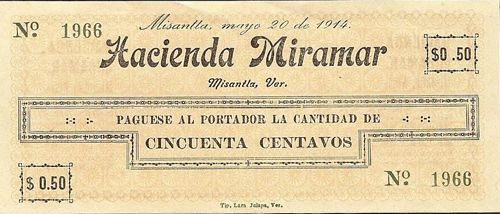
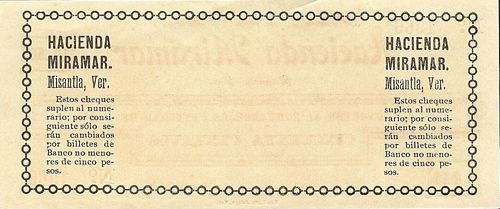
| Date | Additional date on note |
from | to | total number |
total value |
||
| 50c | 20 May 1914 | 15 April 1915 | Handwritten 'Legalizado' and seal includes numbers 0046 to 1963CNBanxico #12306 |
||||
| remainder includes numbers 1514 to 2158 |
|||||||
| signed includes number 3693 |
One peso
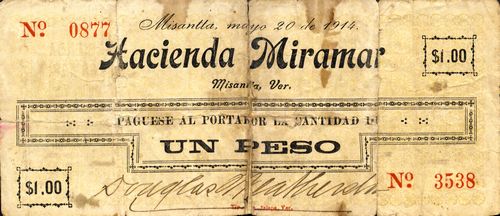
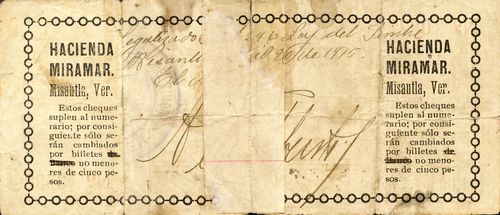
| Date | Additional date on note |
from | to | total number |
total value |
||
| $1 | 20 May 1914 | 15 April 1915 | Handwritten 'Legalizado' and seal includes number 0469CNBanxico #12307 |
||||
| 26 April 1915 | Handwritten 'Legalizado' and seal includes number 3538 |
||||||
| 2 June 1915 | 'No hay timbres' includes number 3777CNBanxico #6411 |
Two pesos
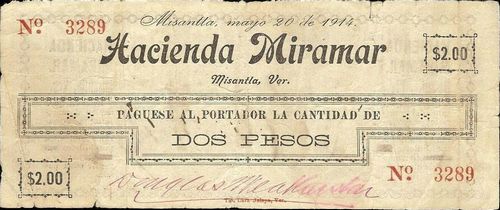
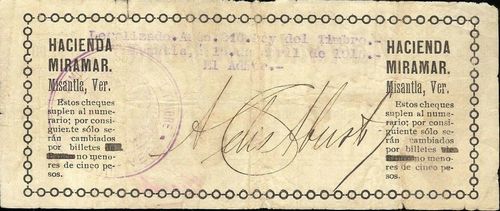
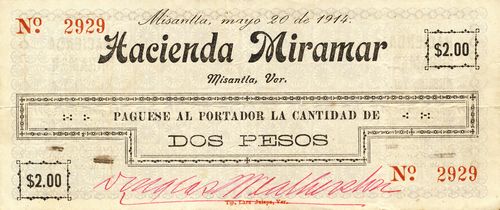
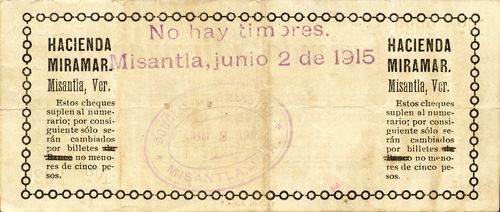
| Date | Additional date on note |
from | to | total number |
total value |
||
| $2 | 20 May 1914 | 15 April 1915 | Typewritten 'Legalizado' and seal includes numbers 0441 to 0910CNBanxico #12308 |
||||
| 15 April 1915 | Typewritten 'Legalizado' and seal includes numbers 3289 to 3719 |
||||||
| May 1915 | Typewritten 'Legalizado' and seal includes numbers 1427 to 1822 |
||||||
| 2 June 1915 | 'No hay timbres. Misantla, junio 2 de 1915' includes numbers 2910 to 2929 |
||||||
| 7 [ ] 1915 | revenue stamp |
Douglas’ son, also Douglas Weatherston, discussed these issues in an interview as part of the Institute of Texan Cultures’ Oral History Program on 7 March 1984http://digital.utsa.edu/cdm/ref/collection/p15125coll4/id/464 thus:
Esther MacMillan: I'm interested in this money …tell me about this …
Douglas Weatherston: As I was telling you, this money here (showing) was issued by my Dad. In March 1914 . Remember the Marines took Vera Cruz in April '14, a month later. And you see, we are in the state of Vera Cruz. But this money was issued because the peso went down to nothing. So what happened … our plantation was away from town … the people who lived up there, you know, the workmen … they got paid. When they came to town, they got paid with Federal money when the Carranzistas took over. The Federal money wouldn't be any good. So, you see, they couldn't buy anything. And vice versa.
And when Zapata's people came in, Zapata's troops, nobody's money was any good. So the government of Mexico allowed my Dad to issue his money to pay the labor from the start … some of it is different dates there.
EM: There's March 1914; July 1914; May 1914.
DW: Okay, it says there that this money would be redeemed with bank notes not less than five pesos each. It says so on the back. I don't know what he put up as collateral, but I think it was the money itself. You see, the people in the town would honor this money.
EM: No less than five pesos it says here. Your father has signed these. This is fascinating. How long was that in effect?
DW: That money was only from, until … issued only those months, after the European war started , we didn't issue any more.
EM: Let's see. March, May and July. Probably July, then sometime in July.
DW: Yeah. I didn't know anything about this money when I went down … I had heard … But I had never seen any of that money. I had heard about it. Because I was at school at that time. Up in Canada. When I went back to Mexico, on a trip, about ten years ago, I went to this little town and this fellow had rolls of this money. He said, "You'd be interested in this." He showed me. "My goodness, I'll buy 'em from you." He said, "No, you can have 'em. I'll give 'em to you."
Then I had my friends buy every bit of the money available. So they bought it. I got 250 of these bills.
EM: You did. I suppose for collectors. People who collect things like that?
DW: Yeah, but he had 'em there; didn't use them anymore but if I had to buy any more I'd have to buy two pesos for one dollar because that's what they were then.
EM: I want to put this on the tape. Each bill of different denominations, each bill says Hacienda Miramar. Then Misantla, Vera Cruz. And they're in denominations of 50 centavos, 1 peso and 2 pesos.
DW: I don't think there were ever any higher than that.
EM: They're signed Douglas Weatherston.
DW: Some of them were printed, the name was printed and some of them written. I have some that he actually signed.
EM: This is signed. The dates … I forgot to put that in … March 20, May 20, and July 1 of 1914.
DW: Yeah.
Cartones
Finally, a series of cartones (5c, 10c, 20c and 40c) dated 15 October 1914
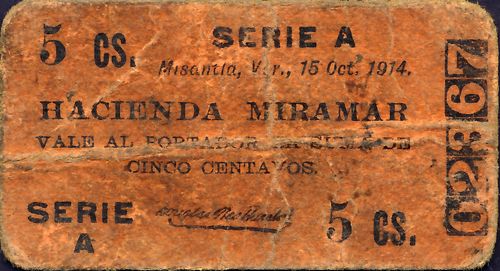
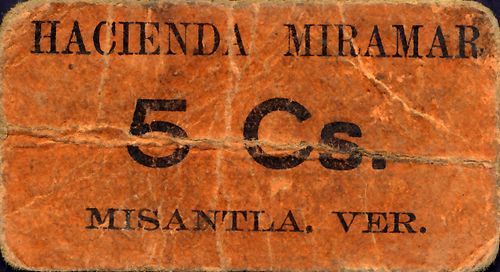
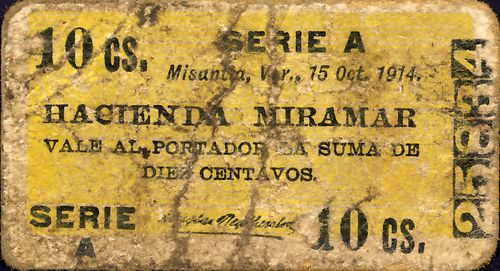
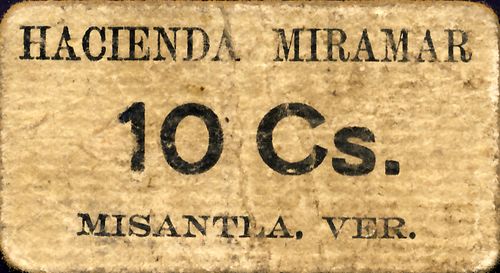
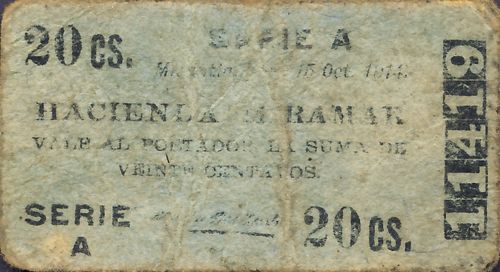
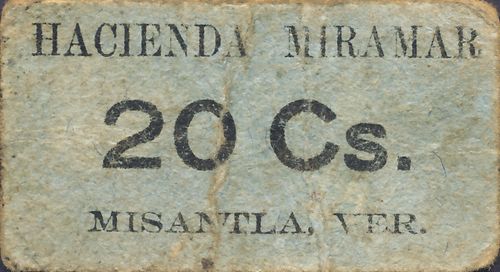
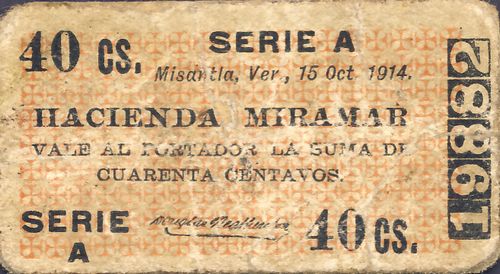
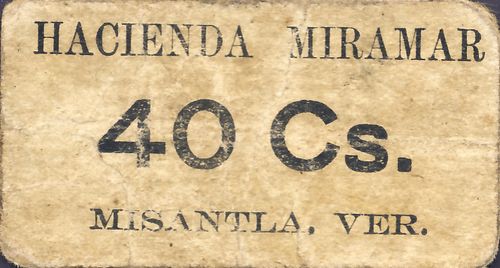
| series | from | to | total number |
total value |
||
| 5c | A | includes numbers 02016CNBanxico #6413 to 24533 | ||||
| 10c | A | includes number 25834 to 28603 | ||||
| 20c | A | includes numbers 11419 to 34224 | ||||
| 40c | A | includes number 17407 to 37200CNBanxico #6417 |

